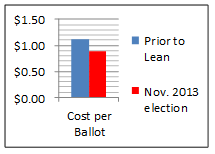What is King County Achieving With Lean?
Lean encourages front-line problem-solving and empowers the employees to improve their work by identifying new efficiencies and eliminating waste—and removing the obstacles that frustrate them.
Rejecting old ways of doing business that frustrated customers and discouraged employees, King County Executive Dow Constantine adopted Lean when he took office. The new culture of continuous improvement is transforming our operations; and we're delivering more value with the resources we have.
The result: Greatly improved customer service, productive employees with higher morale, and better outcomes with significant savings for the people of King County. More of our impacts are highlighted below.
Dramatically improving psychiatric observation of jail inmates
Inmates classified as suicide risk require observation every 15 minutes, but on an average day at the King County Jail 70 inmates were being given that designation, a rate far above industry standard. Intensive Lean work revealed the absence of clear definitions, along with redundancy and rework that led staff to classify many low-risk inmates as psychiatrically impaired — whether warranted or not.
Once the need for clear standards was identified, the number of inmate-patients on 15-minute checks dropped by 90 percent, from 70 per day to around five. Patients are now evaluated sooner and with greater accuracy, which has also improved the quality of care by providing the right treatment based on condition – saving more than $2 million a year.
With Lean, we are no longer putting out clinical “fires,” and that helped create more time to see other waiting patients, and to offer more and better services. Patients are receiving more timely quality care, and my colleagues are more excited to become part of a practice that is ever-evolving and more diverse." -John Rose, Jail Health Services
Providing more coverage and care at Public Health Centers
A rigorous Lean workshop created more efficient use of doctors’ and nurses’ time through improvements in scheduling. After examining historical data on patterns of patient cancellations, appointments are now being scheduled in a way to enable more patients to be seen for treatment in any given period of time, increasing care for homeless adults, low-income pregnant women, and at-risk mothers and their infants.
Lean also led to streamlined Medicaid enrollment by allowing applicants to begin their process without all their paperwork in hand. Within three months, this simple step and others more than doubled the number of clients who were able to enroll, increased by half the number who were approved for coverage on the same day, and brought in up to $1 million more in much-needed Medicaid revenue.
Counting election ballots faster and at less cost with the same accuracy

Conducting accurate and accountable elections is an essential function of a democracy. Using Lean innovations, King County Elections has become a model studied by other jurisdictions for reducing waste and achieving greater efficiencies while managing historically high vote volumes and maintaining ballot accuracy and accountability.
Cross-training of employees in the various tasks of envelope opening, ballot tabulation, and signature verification made each of them better operational problem solvers up and down the line. That helped reduce the number of seasonal temps needed for large elections. Wasted motion was reduced by mapping work flows right down to walking patterns, which led to the cutting of a door in a long wall so that workers no longer needed to walk around it. These actions helped cut the cost of processing each ballot by 20 percent, saving Elections nearly $2 million while preserving the integrity of the elections process.
Cutting the inventory of spare parts for buses
With $18 million invested in spare parts for Metro Transit buses, managers and staff seized the opportunity for Lean transformation when they realized that as many as one-third of those parts had never been used in two years. The process was broken; when a part not in stock was needed, buyers would acquire several “just in case.”
With Lean, formulas were developed to order parts in quantities based on patterns of actual past usage, and inventory was coordinated among different maintenance shops to reduce redundancy—slicing inventory by 30 percent over two years and freeing resources that are being put back into providing bus service to the public.
Developing a culture of Continuous Improvement
We’re continually improving as Lean leaders too. At the Washington State Lean conference in 2014, some of our managers shared how early missteps with Lean tools spurred them as Lean leaders to a deeper, more sustained commitment to building a Lean culture in their operations. That commitment earned trust and buy-in from employees. Today, public and private sector leaders take our Leader Leader Tour.
Daily kaizen on work teams throughout the county is helping us solve more problems, deliver more value to the citizens of King County, and changing how we relate to each other, our work, and our customers.
One of the originators of Lean at Toyota, Sensei Chihiro Nakao, has praised our employees' kaizen ethos as a rarity in government – not just for individual improvements, but for their deeper culture of continuous improvement.
With Executive Constantine’s leadership, we intend to keep building on this record of success.

 Translate
Translate